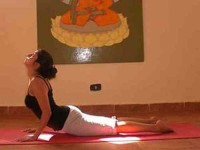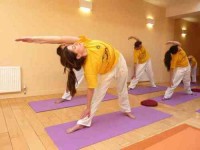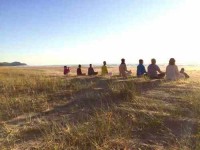Sivananda, one of the world's largest schools of yoga, is very supportive to beginners. Developed by Swami Vishnu-Devananda and named for his teacher, Swami Sivananda, Sivananda Yoga follows a set structure that includes breathing, classic asanas, and relaxation, as well as principles of diet and positive thinking. The Complete Illustrated Book of Yoga, written by Swami Vishnu-Devananda and first published in 1960, was one of the first, and continues to be one of the best, introductions to yoga available.
It is based on the Hatha Yoga teachings of Swami Sivananda Saraswati and his disciple, Swami Vishnu-devananda. Sivananda Yoga focuses on the health of mind and body, as well as on spiritual development.
The philosophy of Sivananda Yoga is summarized in its 'Five Points of Yoga':
Proper exercise (asanas);
Proper breathing (pranayama);
Proper relaxation (savasana);
Proper diet (vegetarianism); and
Positive thinking (Vedanta) and Meditation (Dhyana).
Swami Sivananda accepted the supreme and vital need for what is known as Sadhana-chatushtaya—discrimination, dispassion, divine qualities and a keen yearning for liberation. Whereas the orthodox Rishis, sages, Yogis or holy men waited for the ripe seeker (one who was ready, who had disciplined himself, who had prepared himself) to approach them, Swami Sivananda said that it is perhaps too much to expect a person living in the modern world, assailed on all sides by distractions and temptations, to develop discrimination and dispassion. He said that even in the case of a person who runs away from failure it is possible to find a spark which could be fanned into a big flame. Sometimes if the spark didn’t exist he even ignited it. That was the extraordinary beauty in Swami Sivananda.
One of the methods adopted by him was massive dissemination of spiritual knowledge. It was absolutely and totally indiscriminate.
Swami Sivananda believed that yoga can be practiced by people of all nationalities, no matter from what section of society they happen and what religion they were brought up. It is inspired by Swami Vishnudevananda to distribute worldwide the doctrine of unity in diversity.
Sivananda Yoga refers to the classical, traditional school of yoga. Deeply rooted in Indian culture. Sivananda Yoga School has spread outside India through the work of Swami Vishnudevananda, a pupil and follower of Swami Sivananda.
Sivananda Yoga - the way to physical and mental health!
What is classical yoga? This means that the practice of yoga in this direction requires compliance with certain rules and principles dictated by the wisdom of the ancient Indian Rishis and proven centuries-old experience.
The main feature of Sivananda yoga that activity is carried out in a mode of relaxation state. Relaxation - is the main condition for asanas performed in a state of inner silence and the natural concentration of the mind. Only then will the practice of asanas can be called yoga.
The aim of the Sivananda Yoga is not a development of strength or flexibility. The manifestation of these qualities occurs naturally as a result of correctly performed practice. Very often, the speaker focused on the development of muscle strength suggests some (sometimes very big!), Tension and stress, which, of course, inconsistent and contrary to practice in a state of relaxation. In addition, when a person "weighs" on the performance of asanas, it is difficult to feel the real possibilities of the organism and "hear" his body, hence the injuries and pain in the muscles, not to mention the inability to focus on the inner silence.
Another feature of the Sivananda Yoga
is that the lesson of asana, we always perform in a certain order. The sequence of asanas is focused primarily on the right spine operation and constructed in such a way that for each asana should be different, providing a balanced muscle tension in the opposite direction. The practice is based on the twelve basic asanas provide an optimal healthy functioning of the human body systems. And, of course, the asanas are performed slowly and consciously, becoming also the mental exercises in concentration and meditation. One hour of practice in this way is equivalent to one hour of exercise, one hour of relaxation, meditation, and one hour!
So, in the process, and as a result of complete relaxation and deep, slow breathing a state of composure of mind, peace of mind and total harmony. But the main advantage of traditional yoga is that it is a special state of emotional balance, mental clarity and inner peace experienced in class, gradually, gradually spills over into everyday life, affecting every sphere of daily activities and is a means of achieving spiritual and physical well-being.
Sivananda Yoga is simple and clear to everyone. Anyone can practice it. You do not need additional aids or special equipment - just a bit of space, and a great desire to live a full, healthy and harmonious life.
Viveka is often translated into discrimination. Here was a master who performed indiscriminate charity and undertook indiscriminate dissemination of spiritual knowledge in the hope that one of these pamphlets or books, dropping into the hands of a man at a certain psychological moment, might ignite true Viveka, true aspiration, in him. I’ll give you just one or two instances. He used to send lots of free books to devotees and non-devotees. Among the recipients of these free books were Sir Winston Churchill (Prime Minister, London, Great Britain), President Truman (Washington) and Marshall Stalin (Moscow). Once somebody said, “Swamiji, these will never reach those men.” He replied, “Never mind, they are books after all and they are parcelled and addressed to Moscow, London, Washington. They have got to get there. Somebody has got to open them to find out what the parcel contains. He will read them.”










